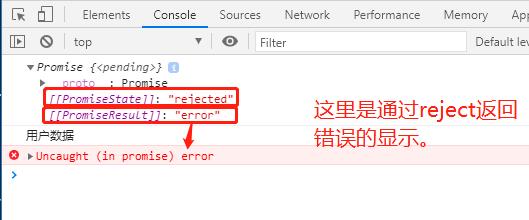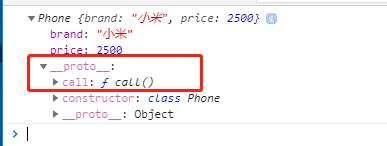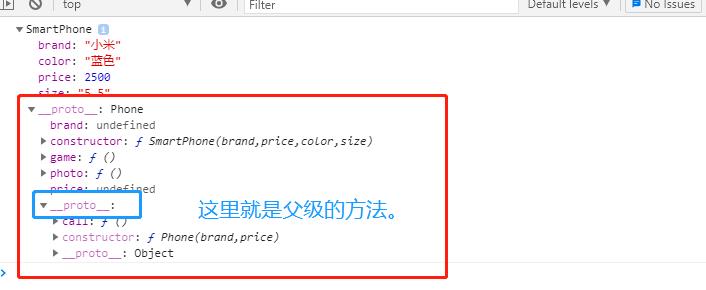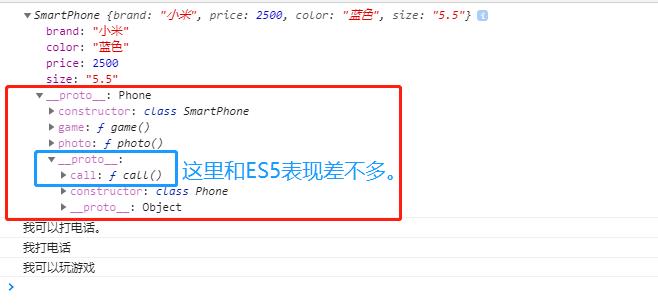ES6 Promise的then方法,Set集合实例,class类各个实现和继承
Posted IT_Holmes
tags:
篇首语:本文由小常识网(cha138.com)小编为大家整理,主要介绍了ES6 Promise的then方法,Set集合实例,class类各个实现和继承相关的知识,希望对你有一定的参考价值。
文章目录
1. ES6 Promise
Promise是ES6引入的异步编程的新解决方法,语法是它是一个构造函数,用来封装异步操作并可以获取其成功或失败的结果。
小插曲:
console.log(data);正常打印data。
console.error(data;会打印出红色错误的data。
console.warn(data);会打印出黄色警告的data。
1.1 Promise then方法
promise有三种情况:初始化,成功,失败(错误)。这里我们使用then方法来演示一下成功和失败后,产出的结果。
<!DOCTYPE html>
<html lang="en">
<head>
<meta charset="UTF-8">
<meta http-equiv="X-UA-Compatible" content="IE=edge">
<meta name="viewport" content="width=device-width, initial-scale=1.0">
<title>Document</title>
</head>
<body>
<script>
//实例化promise
//promise有三种情况:初始化,成功,错误。
const p = new Promise((resolve,reject)=>{
setTimeout(function(){
//如果数据调用成功,则使用resolve方法。成功后它会调用实例对象then方法的第一个携带value参数的函数。
let data = '数据库中的用户数据';
resolve(data);
},1000);
});
//打印promise实例化对象,可以看到有一个then方法
console.log(p);
//调用promise对象中的then方法
p.then((value)=>{
console.log(value);
},(reason)=>{
console.log(reason);
});
</script>
<script>
//实例化promise
//promise有三种情况:初始化,成功,错误。
const p = new Promise(function(resolve,reject){
setTimeout(function(){
//如果数据调用失败,则使用reject方法。失败后它会调用实例对象then方法的第二个携带reason参数的函数。
let err = '数据读取失败';
reject(err);
},1000);
});
//调用promise对象中的then方法
p.then(function(value){
console.log(value);
},function(reason){
console.log(reason);
});
</script>
</body>
</html>
1.2 Promise 读取文件
通过node.js和promise来实现读取文件。其实就是在原来的基础上面加了node.js中的fs模块与promise中的相关参数相结合的操作。
const fs = require('fs');
//使用 promise 封装
const p = new Promise((resolve,reject)=>{
fs.readFile("./fs/测试.md",(err,data)=>{
//如果失败
if(err) reject(err);
//如果成功
resolve(data);
});
});
p.then((value)=>{
console.log(value.toString());
},(reason)=>{
console.log("失败了!")
});
1.3 promise 封装ajax
就是将ajax封装到了promise里面。
<!DOCTYPE html>
<html lang="en">
<head>
<meta charset="UTF-8">
<meta http-equiv="X-UA-Compatible" content="IE=edge">
<meta name="viewport" content="width=device-width, initial-scale=1.0">
<title>Document</title>
</head>
<body>
<script>
//这里就是将ajax封装到了promise里面。
const p = new Promise((resolve, reject) => {
//ajax的四个步骤
const xhr = new XMLHttpRequest();
xhr.open("GET", 'https://api.apiopen.top/getJoke');
xhr.send();
xhr.onreadystatechange = function () {
if (xhr.readyState === 4) {
if (xhr.status >= 200 && xhr.status < 300) {
resolve(xhr.response);
} else {
reject(xhr.status);
}
}
};
});
p.then((value)=>{
console.log(value);
},(reason)=>{
console.error(reason);
});
</script>
</body>
</html>
1.4 Promise then方法
一定要记住以下4种情况。
1.then方法返回的是非promise类型。
2.then方法返回的是promise类型。
3.then方法返回throw,抛出错误。
4.then方法不返回,默认是undefined,不会报错。
对于上面,第一种情况,如果then方法返回的结果是非promise类型,并且状态为成功,则返回值为对象成功的值。
第二种情况,对于then方法的返回结果是Promise对象,对象状态由回调函数的执行结果决定。
案例:
<!DOCTYPE html>
<html lang="en">
<head>
<meta charset="UTF-8">
<meta http-equiv="X-UA-Compatible" content="IE=edge">
<meta name="viewport" content="width=device-width, initial-scale=1.0">
<title>Document</title>
</head>
<body>
<script>
//创建promise对象
const p = new Promise((resolve,reject)=>{
setTimeout(()=>{
resolve("用户数据");
// reject("错误");
},1000);
});
const result = p.then(value => {
console.log(value);
//1. 非promise类型的属性
// return '非promise';
//2. 是promise对象。对应两种resolve正常抛出和reject错误抛出
// return new Promise((resolve,reject)=>{
// // resolve('ok'); //resolve正常抛出
// reject('error'); //使用reject抛出错误
// });
// 3. throw 抛出错误
// throw "error";
},reason => {
console.warn(reason);
});
console.log(result);
</script>
</body>
</html>

1.5 Promise then方法读取多个链式文件异步
完成类似的这种链式关系,可以再次在then方法内返回一个Promise对象,这就是一个重点。
案例:
const fs = require('fs');
const { resolve } = require('path/posix');
// 通过promise来实现下面注释代码的内容。
// fs.readFile("./fs/测试.md",(err,data)=>{
// fs.readFile("./fs/测试2.md",(err2,data2)=>{
// fs.readFile("./fs/测试3.md",(err3,data3)=>{
// let result = `${data}${data2}${data3}`;
// console.log(result);
// });
// });
// });
const p = new Promise((resolve, reject) => {
fs.readFile("./fs/测试.md", (err, data) => {
resolve(data);
});
});
p.then((value) => {
//完成上面的那种链式关系,可以再次在then方法内返回一个Promise对象。
return new Promise((resolve, reject) => {
fs.readFile("./fs/测试2.md", (err, data) => {
resolve([value, data]);
});
})
}).then((value) => {
return new Promise((resolve, reject) => {
fs.readFile('./fs/测试3.md', (err, data) => {
//此时这里的value已经是一个数组了。
value.push(data);
resolve(value);
})
});
}).then((value) => {
//打印上面的三个结果
console.log(value.join('\\r\\n'));//将数组内的结果进行拼接,添加上回车。
});
1.6 Promise catch
catch和then方法没多大区别,都可以抛出错误。
<!DOCTYPE html>
<html lang="en">
<head>
<meta charset="UTF-8">
<meta http-equiv="X-UA-Compatible" content="IE=edge">
<meta name="viewport" content="width=device-width, initial-scale=1.0">
<title>Document</title>
</head>
<body>
<script>
const p = new Promise((resolve, reject) => {
setTimeout(
() => {
reject('出错了');
}
, 1000);
});
//正常抛出错误我们使用reject和reason参数来实现。
// p.then((reason)=>{
// console.error(reason)
// })
//这里我们使用catch来实现抛出错误。
p.catch((reason) => {
console.error(reason);
});
</script>
</body>
</html>
2. ES6 新的数据结构Set(集合)
2.1 Set 集合介绍
ES6提供了新的数据结构Set(集合)。类似于数组,但成员的值都是唯一的,因为集合实现了iterator接口,所以可以使用扩展运算符和for … of 来进行遍历。
集合的属性和方法:
1. size 返回集合的元素个数。
2. add 增加一个新元素,返回当前集合。
3. delete 删除元素,返回boolean值。
4. has 检测集合中是否包含该元素返回boolean值。
5. 使用clear() 清空集合内容。
6. 使用for … of 来遍历集合。
案例:
<!DOCTYPE html>
<html lang="en">
<head>
<meta charset="UTF-8">
<meta http-equiv="X-UA-Compatible" content="IE=edge">
<meta name="viewport" content="width=device-width, initial-scale=1.0">
<title>Document</title>
</head>
<body>
<script>
//创建一个set对象。
let s = new Set();
let s2 = new Set(['111', '222', '333', '444', '555', '666']);
//使用for ... of遍历数据
for(let v of s2){
console.log(v);
}
//size属性,元素个数。
console.log(s2.size);
//add属性 , 添加
console.log(s2.add('777'));
//delete属性,删除元素
console.log(s2.delete('111'));
//has属性 ,检测集合。
console.log(s2.has('222'));
//clear() ,来清空集合。
s2.clear()
console.log(s2);
</script>
</body>
</html>
2.2 Set集合实用
通过下面的案例能够更加了解Set对象一些特性。Set对象内部没有重复的数据,所以经常转换数组一些小操作,例如:数组去重,算交集,并集,差集等。
<!DOCTYPE html>
<html lang="en">
<head>
<meta charset="UTF-8">
<meta http-equiv="X-UA-Compatible" content="IE=edge">
<meta name="viewport" content="width=device-width, initial-scale=1.0">
<title>Document</title>
</head>
<body>
<script>
//集合有几个小案例可以实现:如下几点。
//1.数组去重
const arr = [1,2,3,4,5,6,1,1,1,2,2,3,4,5,6,3];
let result = [...new Set(arr)]; //先定义为将arr传给Set对象,后使用扩展运算符和数组,生成数组。
console.log(result);
//2.两个数组的交集
const arr2 = [4,5,8,9,0];
//使用filter过滤
let result2 = [...new Set(arr)].filter(item => {
let s2 = new Set(arr2);
if(s2.has(item)){
return true;
} else {
return false;
}
});
console.log(result2);
// 也可以直接简化成下面的样子,推荐使用下面的例子。
let result3 = [...new Set(arr)].filter(item => new Set(arr2).has(item));
console.log(result3);
//3. 求数组并集
let union = [new Set([...arr,...arr2])];
console.log(union);
//4.求数组差集
//这里的差集就是交集的逆运算。
let diff = [...new Set(arr)].filter(item => !new Set(arr2).has(item));
console.log(diff);
</script>
</body>
</html>
3. ES6 Map数据结构
ES6提供了Map数据结构。它类似于对象,也是键值对的集合。但是," 键 "的范围不限于字符串,各种类型的值(包括对象)都可以当作键。Map也是先了iterator接口,因此,也可以是用扩展运算符和for … of进行遍历。
map的属性和方法:
1. size Map元素的个数。
2. set 增加一个新元素,返回当前的Map。
3. get 返回键名对象的键值。
4. has 检测Map中是否包含某个元素,返回boolean值。
5. delete 删除某个元素,要指定键名。
6. clear() 清空,返回undefined。
案例:
<!DOCTYPE html>
<html lang="en">
<head>
<meta charset="UTF-8">
<meta http-equiv="X-UA-Compatible" content="IE=edge">
<meta name="viewport" content="width=device-width, initial-scale=1.0">
<title>Document</title>
</head>
<body>
<script>
//1. set 添加map元素。
m = new Map();
m.set('name','张三');
m.set('age',"18");
m.set('change',function(){
console.log("法外狂徒张三");
});
//可以声明key,key也可以是键。
let key = {
school: '清华'
}
m.set(key,['张三','李四','王五']);
console.log(m);
//2. size 查看Map的元素个数。
console.log(m.size);
//3. delete 删除Map的某个元素。
m.delete('age');
console.log(m);
//4. get 获取Map的某个元素
m1 = m.get(key);
console.log(m1);
//5. for ... of 遍历
console.log("下面是遍历:")
for(let v of m){
console.log(v);
}
//5. clear() 清空
console.log(m.clear());
</script>
</body>
</html>
4. ES6 class类
4.1 了解ES5的实现方法
ES5一般是用prototype来给函数创建方法来调用的。
<!DOCTYPE html>
<html lang="en">
<head>
<meta charset="UTF-8">
<meta http-equiv="X-UA-Compatible" content="IE=edge">
<meta name="viewport" content="width=device-width, initial-scale=1.0">
<title>Document</title>
</head>
<body>
<script>
//ES5的实现方法。
function Phone(brand, price) {
this.brand = brand;
this.price = price;
}
//向Phone添加方法
Phone.prototype.call = function () {
console.log("我可以打电话!");
}
//实例化对象
let xiaomi = new Phone('小米', 2500);
//调用call方法
xiaomi.call();
console.log(xiaomi);
</script>
</body>
</html>

4.2 ES6 的class实现
这里使用class来模拟上面情况,需要注意的是:constructor构造函数固定,方法定义格式必须要个按照下面定义的形式。
<!DOCTYPE html>
<html lang="en">
<head>
<meta charset="UTF-8">
<meta http-equiv="X-UA-Compatible" content="IE=edge">
<meta name="viewport" content="width=device-width, initial-scale=1.0">
<title>Document</title>
</head>
<body>
<script>
class Phone {
//构造方法,名字不能修改!!!
constructor(brand, price) {
this.brand = brand;
this.price = price;
}
//定义call方法格式如下:
call() {
console.log("我可以打电话!");
}
}
let xiaomi = new Phone("小米", 2500);
console.log(xiaomi);
</script>
</body>
</html>

4.3 class 静态成员
要理解:实例对象 , 函数对象 , 类的调用关系!!
注意一下几点:
1. 实例对象属性和函数对象的属性不是互通的。不能相互调用。
2. 实例对象的属性和构造函数的原型对象是想通的
<!DOCTYPE html>
<html lang="en">
<head>
<meta charset="UTF-8">
<meta http-equiv="X-UA-Compatible" content="IE=edge">
<meta name="viewport" content="width=
, initial-scale=1.0">
<title>Document</title>
</head>
<body>
<script>
function Phone(){
}
//这里设置的是函数对象的属性,并不属于实例对象。
Phone.name = '手机';
Phone.change = function(){
console.log("我能打电话");
};
//这里设置的构造函数原型对象的size方法。
Phone.prototype.size = "5.5inch";
//因为上面的name和change是函数对象的属性,而不是实例对象属性,所以实例对象不能调用。
let xiaomi = new Phone();
console.log(xiaomi.name);
// console.log(xiaomi.change());
//实例对象的属性和构造函数的原型对象是想通的!!!因此这里可以调用。
console.log(xiaomi.size);
</script>
</body>
</html>
对于class而言,和上面差不多,静态成员是static定义的。而且需要记住在class中定义的static,属于类,并不能被实例对象所调用。
<!DOCTYPE html>
<html lang="en">
<head>
<meta charset="UTF-8">
<meta http-equiv="X-UA-Compatible" content="IE=edge">
<meta name="viewport" content="width=
, initial-scale=1.0">
<title>Document</title>
</head>
<body>
<!-- <script>
function Phone(){
}
//这里设置的是函数对象的属性,并不属于实例对象。
Phone.name = '手机';
Phone.change = function(){
console.log("我能打电话");
};
//这里设置的构造函数原型对象的size方法。
Phone.prototype.size = "5.5inch";
//因为上面的name和change是函数对象的属性,而不是实例对象属性,所以实例对象不能调用。
let xiaomi = new Phone();
console.log(xiaomi.name);
// console.log(xiaomi.change());
//实例对象的属性和构造函数的原型对象是想通的!!!因此这里可以调用。
console.log(xiaomi.size);
</script> -->
<script>
class Phone {
//从结果看出static标出的属性(name)或者方法change(),它属于类class,并不属于实例对象。
static name = "手机";
static change() {
console.log("我可以打电话");
}
}
let xiaomi = new Phone();
console.log(xiaomi.name); //打印出undefined。
console.log(Phone.name); //打印出手机。
</script>
</body>
</html>
4.4 ES5的继承表现
ES5的继承主要通过函数的prototype来实现。
注意下面:
设置子级函数构造函数的原型是父级函数,这样子级函数就可以调用父级函数的方法了。
<!DOCTYPE html>
<html lang="en">
<head>
<meta charset="UTF-8">
<meta http-equiv="X-UA-Compatible" content="IE=edge">
<meta name="viewport" content="width=device-width, initial-scale=1.0">
<title>Document</title>
</head>
<body>
<script>
//ES5的构造函数继承
//定义一个父级Phone
function Phone(brand,price){
this.brand = brand;
this.price = price;
}
//定义父级方法call
Phone.prototype.call = function(){
console.log("我可以打电话");
}
//定义一个子级SmartPhone
function SmartPhone(brand,price,color,size){
Phone.call(this,brand,price);
this.color = color;
this.size = size;
}
//设置子级SmartPhone构造函数的原型
SmartPhone.prototype = new Phone; //这样SmartPhone的实例对象,就会有父级的Phone的方法。
SmartPhone.prototype.constructor = SmartPhone;
SmartPhone.prototype.photo = function(){
console.log("我可以拍照");
}
SmartPhone.prototype.game = function(){
console.log("我可以玩游戏。");
}
let xiaomi = new SmartPhone("小米",2500,'蓝色','5.5');
console.log(xiaomi);
</script>
</body>
</html>

4.6 class类继承表现
对于class继承,就和后端语言差不多形式,extends的继承。
注意:
可以进行函数重载,就是重新在子类定义函数即可。
super()这个方法,只能用于constructor构造函数,不能用于其他的普通方法中。
<!DOCTYPE html>
<html lang="en">
<head>
<meta charset="UTF-8">
<meta http-equiv="X-UA-Compatible" content="IE=edge">
<meta name="viewport" content="width=device-width, initial-scale=1.0">
<title>Document</title>
</head>
<body>
<script>
class Phone{
constructor(brand,price){
this.brand = brand;
this.price = price;
}
call(){
console.log("我可以打电话。");
}
}
class SmartPhone extends Phone{
constructor(brand,price,color,size){
super(brand,price);
this.color = color;
this.size = size;
}
photo(){
console.log("我打电话");
}
game(){
console.log("我可以玩游戏");
}
}
let xiaomi = new SmartPhone("小米",2500,'蓝色','5.5');
console.log(xiaomi);
xiaomi.call();
xiaomi.photo();
xiaomi.game();
</script>
</body>
</html>

4.7 class 的getter 和 setter
在ES5中,get和set,分别是获取属性和设置属性。而ES6中,get(getter)和set(setter)的表现有所不同。
需要注意:
set设置方法时,要有参数,因为set是设置内容,要有参数传递。
<!DOCTYPE html>
<html lang="en">
<head>
<meta charset="UTF-8">
<meta http-equiv="X-UA-Compatible" content="IE=edge">
<meta name="viewport" content="width=device-width, initial-scale=1.0">
<title>Document</title>
</head>
<body>
<script>
class Phone{
//设置get
get price(){
console.log("小米手机价格实惠。");
return '2500';
}
}
let s = new Phone();
console.log(s.price);//调用类中price的内容和返回值。
</script>
<script>
class Phone1{
//设置class的set,注意因为是设置,所以price1要有一个参数。
set price1(newVal){
console.log("设置price1属性。");
}
}
let s1 = new Phone1();
s1.price1 = '2500';//给price1设置时,就会调用price1下面内容。
</script>
</body>
</html>
以上是关于ES6 Promise的then方法,Set集合实例,class类各个实现和继承的主要内容,如果未能解决你的问题,请参考以下文章